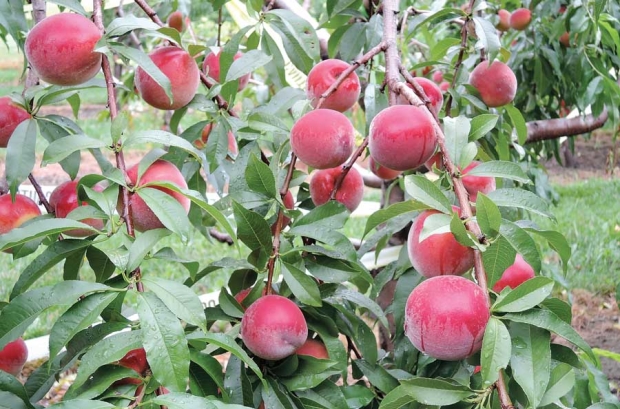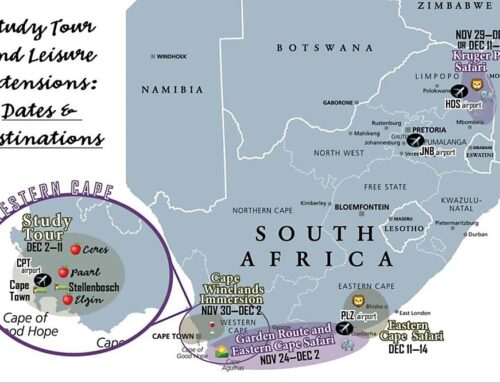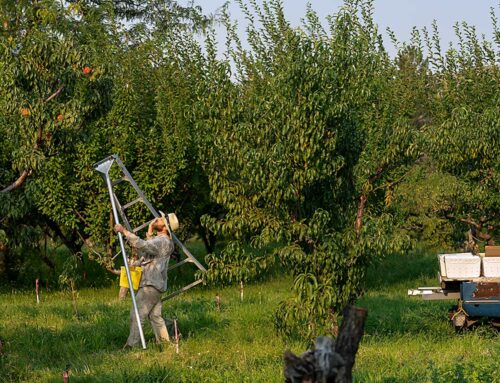
Vee Blush, a new yellow-fleshed peach variety, is a candidate to replace Harrow Diamond. (Courtesy Ontario Tender Fruit Evaluation Committee)
A reinvigorated industry is on the horizon for Canada’s Ontario stone fruit growers, three years after the formation of a committee that puts industry stakeholders in the field alongside the breeder in test plots.
Stone fruit research in Ontario languished following the retirement in 1995 of Dr. Richard “Dick” Layne, who had overseen fruit breeding activities at the federal research station in Harrow, Ontario.
Some of the most promising selections were transferred to the provincial research station in Vineland, but little was done with them.
The discovery of plum pox virus (PPV) in 2000 effectively halted breeding and propagation activities, as well as the work of the Ontario Fruit Testing Association (OFTA), which had previously received plant material for testing.
During the past two decades, just four peach varieties have been released: Vollie, on the occasion of the centennial of the Vineland station in 2006, Vee Blush, Virtue and White Knight, all designed to fill gaps in the market. Of these, the early season variety Vee Blush has attracted the most interest.
Now, a host of new peach and nectarine varieties could be ready as early as 2018, thanks to the efforts of the Ontario Tender Fruit Evaluation Committee, established in 2012 with money remaining from the OFTA to guide breeding and commercialization activities.
The committee officially formed as a partnership between the Ontario Tender Fruit Growers (OTFG), the University of Guelph, and the Vineland Research and Innovation Centre, which now operates the Vineland research facility.
Committee members who are engaged in outreach to stone fruit growers include Jay Subramanian, a professor of tree fruit breeding and biotechnology at the University of Guelph in Vineland who oversees the breeding activities; OTFG general manager Sarah Marshall; and Michael Kauzlaric, a researcher with the Vineland Research and Innovation Centre.
The committee meets weekly during the growing season, reviewing about 60 varieties a year.
The meetings usually attract 15 growers and industry members from nurseries to packers who provide feedback, bringing them into the discussions.
“They look at it from a different angle than what we as breeders look at it,” Subramanian said. “It’s not what I like that is important, it is what the growers like.”
Subramanian said of the four peach and four nectarine varieties on trial in commercial orchards right now, two might not have made the cut without feedback from industry.
“I might have very well removed them because they weren’t in any way comparable to Vee Blush in terms of quality,” he said. “But the point the industry made was, ‘Yeah, that’s true, Jay, but look at those fruits — they’re large and they come a good week to 10 days before Vee Blush, which means we have that window and any fruit that goes early into the market will give us that extra dollar.’”
It’s not only growers who stand to profit from participation in the variety selection process; the more appealing a variety release, the greater the uptake and, in turn, the greater the licensing fees it generates. This makes for a more cost-efficient selection process from start to finish.
“It’s the way that Ontario wants to see new varieties being brought on. It’s a three-year filtering process, and after the third year, it’s a go or no-go, essentially,” said Kauzlaric, who helps growers identify new varieties on behalf of Vineland, which commercializes the new varieties on behalf of the breeders (fulfilling a function similar to that of Summerland Varieties Corp., formerly the Okanagan Plant Improvement Corp., in British Columbia).
With eight new stone fruit varieties nearing release, Kauzlaric is keen to offer new, locally developed varieties alongside existing selections from programs at Rutgers and in Michigan. He said the committee hopes within 12 months to have a handful of varieties named and available for commercial planting in 2018.
That’s good news to Phil Tregunno of Tregunno Fruit Farms Inc. near Niagara-on-the-Lake and chair of the Ontario Tender Fruit Growers.
“The evaluation committee brings marketers, growers, nursery operators and researchers all together to share information which has been very beneficial in ramping up production,” he said. “Vineland varieties of peaches and nectarines, as well as fire blight-resistant pears and improved varieties of apricots, are all being planted, which give growers a longer production season and consumers a wider choice of local fruit replacing imports.” •
– by Peter Mitham, a freelance writer based in Vancouver, British Columbia.






Leave A Comment